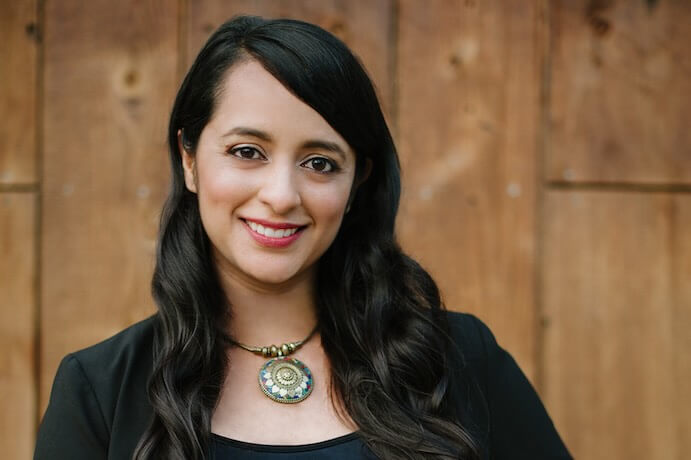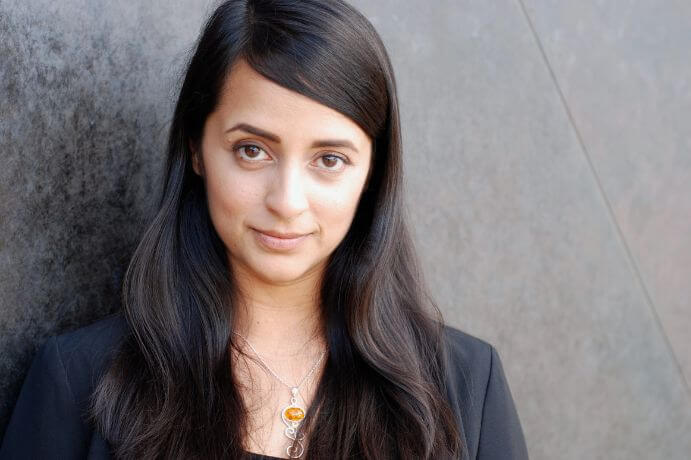Reena Esmail’s sweeping, passionate compositions take elements of Hindustani music, elements of Western classical music, and fuse them together to create something entirely new. As an Indian American composer, she acknowledges that she is a rarity in the world of Western classical music. Nevertheless, she has found success across several parts of the music world. Currently, she serves as the Artist-in-Residence at the Los Angeles Master Chorale, as well as the Artistic Director and co-founder of Shastra, a nonprofit that works to promote cross-cultural collaboration between South Asian and Western musicians.
Esmail is part of a new Indian American story. Before 1965, the Indian American population was quite small, largely due to restrictive quotas imposed on immigrants of color by the American government. After the passage of the 1965 Immigration Act, a significant number of South Asians began settling in the US and raising their families in the West; the children of these post-1965 Indian immigrants are responsible for creating an Indian-American culture: politically, socially, and artistically.
Born in 1983, Esmail has had a leading role in shaping that third culture in the world of contemporary classical music. The concept of being a ‘third culture kid’ was coined by sociologists in the 1950s, but the term began circulating more widely in the early 2000s. In our phone interview this February, Esmail acknowledged that her work both predates and postdates popular usage of the term, but the concept nonetheless resonates with her work.
“That’s absolutely what this is: you’re taking everything you know from one culture and from another culture, and you’re making something that is a synthesis, that feels like a new thing.” She continued, “Say for example there was a language that you could speak, where you could say the same words, but if you spoke French you could understand it in French, and if you spoke English, you could understand it in English. That is the essence of what I’m trying to do in my work.” Ultimately, she hopes her music functions as “one singular thing that two people are listening to, but they’re each processing completely through their own cultural lens.”
Unlike East Asians, South Asians are not found in large numbers in the professional landscape of Western classical music. Esmail noted that the first generation children of South Asian immigrants are often asked to pursue careers with stable financial returns in order to make the ‘investment’ of immigration worthwhile. She was allowed more freedom as a child, though, which she attributes to her parents’ personal histories.
“My parents were each kind of the maverick, the crazy one in their family, who wanted to do stuff that their parents didn’t want them to do. And then they married one another! […] I think that’s the reason why they were like, ‘oh yeah, you want to do music? Go right ahead!’” So Esmail chased her dreams, graduating with a Bachelor of Music degree from Juilliard in 2005.

Esmail was composing as early as 1999, but she became a truly syncretic composer after the time she spent studying the Hindustani musical tradition of North India as a Fulbright-Nehru scholar between 2011 and 2012. In her piano studies, she had always been attracted to the color, texture, and melodic freedom of French music, and she found herself using this training in the Western classical tradition as a lens through which to understand Hindustani music.
Esmail is not the first composer in the Western classical tradition to be inspired by the music and history of South Asia, by any means. Gustav Holst, for example, wrote explicitly about the Rig Veda. But unlike Esmail, who knows the connection that comes with claiming India as your “ancestral home,” many of those composers had an outsider’s relationship to the region and its cultural traditions.
Describing her first visit to India, Esmail summed up the feeling simply; she said it was like exhaling and simply knowing that, “you’re back.” That sense of ownership, rather than exoticization, has informed Esmail’s relationship with Hindustani music. “Debussy went and heard gamelan music and was super inspired by that because he felt some kind of connection/resonance to his own music. If you take that the opposite way, I started studying Hindustani music, and I realized that it connected back into Western classical music through the French tradition, essentially. And so, my music is almost the reverse of Debussy’s music because it’s not exoticizing Indian music – it’s using French music to contextualize stuff that actually comes from the Hindustani classical tradition.”
Esmail sees the two musical styles she bridges as effectively complementary because of how differently they have evolved over time. The complexity in Hindustani music is not built through harmonic intricacy; in general, the harmonic structure is limited to a one-note drone, while heavy ornamentation in the melody introduces variety into a piece. A tradition like Hindustani music – where music is passed down orally, instead of through notation – allows for more improvisational intricacy in the melodic line: just as a folk tale might change from one generation to the next, each Hindustani singer adds their own variation to the melody they’ve learned by ear from their guru.

Meanwhile, Western classical music has developed complexity through the use of precise counterpoint and layered harmonies. In order to make those structures function, improvisation has to be limited in a Western melody; this is further constrained by the emphasis placed on the notated tradition in Western music.
Esmail sees an opportunity for synthesis in this oppositional evolution of the two musical forms. “Because there is no harmony and counterpoint in Hindustani music, and there’s not that level of mellifluous [lyricism] in Western music, there’s not something that each of those things is replacing,” she explained. “So in a way, because they privilege such different things, they are able to do both at the same time without conflict.”
However, the performers who Esmail works with have typically been trained with a focus in one tradition or the other, which means they might interpret notation differently or have varying understandings of microtonal melodic forms. To overcome these differences, Esmail often orally communicates her compositional ideas and intentions to performers. “I’ll just sing it for the first people who play it. I’ll say, ‘I just want you to imitate it,’ because of course that’s the way that Hindustani musicians learn.”
The Western-style harmonic structures that Esmail writes create a strong swell to her music. You can hear it clearly in works like This Love Between Us, a work for choir and Baroque orchestra that explores the variety of religious traditions in South Asia. The wavering, quick, and complex melodies pull the listener along on their own. But when the choir is added, with layers and depth that Hindustani-style melodies don’t normally have, the combination adds power to the music, a weight that seems to part the air before the listener’s path. The canonical Western works that come to mind as comparisons are pieces like Smetana’s Moldau or Debussy’s La Mer. These works tell stories about rushing rivers and flowing seas; that sense of power in water also infuses Esmail’s layered, driving compositions. Like a swirling tide, Esmail’s music captures you.
Looking forward, Esmail is eagerly anticipating the future of South Asian-American music. “There are a lot of young people who play my music. They’re playing the heck out of it! They’re really at a very high level, and they’re really young.” The barriers she broke through, and indeed the world that formed her music, is opening up. She says with pride, “It’s changing. It’s changing.”
I CARE IF YOU LISTEN is an editorially-independent program of the American Composers Forum, and is made possible thanks to generous donor and institutional support. Opinions expressed are solely those of the author and may not represent the views of ICIYL or ACF.
You can support the work of ICIYL with a tax-deductible gift to ACF. For more on ACF, visit the “At ACF” section or composersforum.org.
























